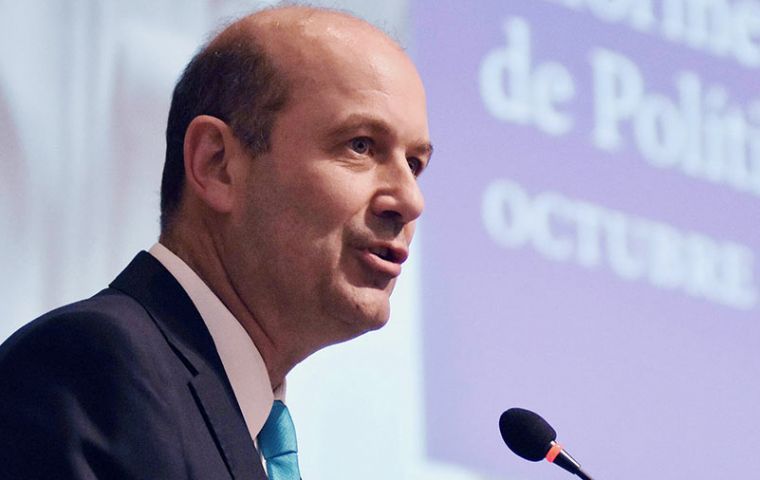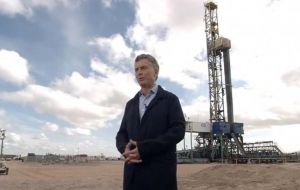MercoPress. South Atlantic News Agency
Argentina's recurring nightmare
 Federico Sturzenegger, the central bank governor from 2015 to 2018, argues that proper accounting implies that public debt was 40% of GDP, not 22%
Federico Sturzenegger, the central bank governor from 2015 to 2018, argues that proper accounting implies that public debt was 40% of GDP, not 22%  The Macri administration removed some energy subsidies, but it also cut taxes, increased pensions, and lost resources after an adverse Supreme Court ruling
The Macri administration removed some energy subsidies, but it also cut taxes, increased pensions, and lost resources after an adverse Supreme Court rulingBy Andrés Bello (*) - Argentine President Mauricio Macri seems almost certain to lose his country’s presidential election next month, after committing the same kinds of economic policy mistakes that so many of his Peronist predecessors made. It is a tragic and catastrophically disappointing denouement.
Argentina has done it again: inflation is up, growth is down, and the peso has lost two-thirds of its value. Depositors have been rushing to withdraw their money from local banks, and a debt default looms. While Argentines suffer the consequences, the world emits a collective sigh of disbelief: wasn’t this time supposed to be different?
It was. President Mauricio Macri’s inauguration in December 2015 unleashed high expectations. Macri recruited an all-star team of technocrats and made encouraging noises about economic reform. After years of corruption and mismanagement under Peronist administrations, the only way was up – or so it seemed.
Instead, the government spent too much, taxed too little, borrowed excessively, failed to discipline its own monetary policy, and eventually was the victim of a massive market panic. Macri’s likely political defeat in the presidential election on October 27 thus will have been caused by the same types of mistakes made by his Peronist predecessors. It is a catastrophically disappointing denouement.
Macri initially proposed cleaning up the huge fiscal mess he inherited gradually, over the four years of his administration. The political argument was that his administration should not resemble the shock-treatment-loving, right-wing governments of the last three decades of the twentieth century. The economic argument was that the government could afford to borrow along the adjustment path, because debt was low (after all, Argentina had defaulted in 2001 on its nearly US$ 100 billion debt).
Both arguments seemed plausible, and market participants happily went along. But today we know that initial conditions were not so benign. In a recent paper, Federico Sturzenegger, the central bank governor from 2015 to 2018, argues that proper accounting (including, for example, the undocumented pension liabilities the government acquired when it nationalized the private social security system) implies that public debt was 40% of GDP, not 22%. To that one should add the central bank’s gaping equity hole, amounting to some US$ 93 billion.
Rather than going down, however gradually, the deficit in 2016 actually increased. The administration removed some energy subsidies, but it also cut taxes (on exporters, small firms, and the middle class), increased pensions, and lost resources after the Supreme Court ruled in favor of provincial governments in a long-running tax dispute. Not counting the temporary revenue produced by a tax amnesty, the primary deficit rose from 3.8% of GDP in 2015 to 5.2% in 2016. Fiscal adjustment was scanty until early this year; by then, it was too late.
The government financed its deficits by borrowing abroad. While the central bank took measures to discourage private speculative inflows, the finance ministry brought in bundles of dollars. The results were predictable: an exchange rate that for long periods seemed overvalued, and little new investment in the export sector.
As for price stability, Argentina followed conventional wisdom and quickly adopted an inflation-targeting regime. Sturzenegger makes much of the fact that core inflation fell throughout his tenure. But headline inflation was highly volatile, reflecting huge utility price increases and a very erratic exchange rate. The pass-through from the exchange rate to prices fell but remained high, and every time headline inflation targets were missed (which happened often), credibility took a hit.
Inflation targeting has worked well enough in countries where inflation was already low. But to get there, successful inflation targeters like Chile, Israel, and Poland initially employed some combination of currency pegs, dual exchange rates, income policies, or all of the above. The Argentine authorities, by contrast, ruled out a currency peg because of the traumatic experience with the one-to-one dollar peg two decades ago. And income policies would have required negotiating prices and wages with union bosses regarded as political adversaries. But it seems plausible that in an economy like Argentina’s, with a long history of inertial inflation and toxic feedback loops between prices and the exchange rate, disinflation would have been faster had policymakers relied on additional tools other than the interest rate.
Moreover, successful inflation targeting assumes prudent fiscal policy and central-bank autonomy. As Sturzenegger makes plain in his paper, Argentina met neither prerequisite. In December 2017, Macri’s political enforcers pressured Sturzenegger to raise the central bank’s inflation targets and, a few weeks later, to cut interest rates twice, by a cumulative 250 basis points.
It was the beginning of the end. While other inflation-targeting countries have relaxed targets without dire consequences, they did not suffer from Argentina’s combination of weak underlying conditions and limited government credibility. Investors headed for the exits, the peso depreciated, and country risk spreads soared. Because debt was dollar-denominated, as the exchange rate weakened from 20 to 40 to the dollar, the debt-to-GDP ratio doubled almost overnight. Soon enough, Argentina was asking the International Monetary Fund for a bailout.
Late 2017 was a strange time for Macri to lose his cool. He and his coalition, called Cambiemos, had triumphed over the Peronist Justicialist Party in that October’s legislative and gubernatorial elections, even in the Peronists’ traditional stronghold of Buenos Aires Province. If ever there was a time to put Argentina’s fiscal house in order and pursue disinflation, this was it. Instead, for reasons that remain unknown, Macri browbeat the central bank into a mistimed monetary loosening.
It also remains to be explained why Macri’s highly-trained technocrats took so long to sound the alarm over fiscal laxity and excessive debt accumulation. The figures were known all along (though perhaps not well understood). Markets, too, were complacent – until they weren’t.
It didn’t have to be this way. While Macri was right to steer away from shock treatment, he likely had more political capital than he thought: voters backed his coalition in October 2017 even though utility prices had gone through the roof, inflation remained high, and slow growth persisted. Macri could have spent more of that political capital on a gradual – but substantial – fiscal adjustment early on, pushed sooner for pension reform, and tacked further left on issues like human rights and abortion, where, as an avowed liberal, he should have been less timid.
But he did not. Sadly, it may be a generation until Argentina gets another chance like the one Macri had.
(*) Andrés Velasco. A former presidential candidate and finance minister of Chile, is Dean of the School of Public Policy at the London School of Economics and Political Science. He is the author of numerous books and papers on international economics and development, and has served on the faculty at Harvard, Columbia, and New York Universities.




Top Comments
Disclaimer & comment rules-

-

-

Read all commentsAnother common concept about inflation is low productivity, i.e: Economic output is not on par with the promise of value of its monetary base. Hence, currency looses value, prices go up, salaries must be increased and savings suffer.
Oct 03rd, 2019 - 10:15 pm +3So it is pretty much two sides of the same coin, either printing too much for the value of your economy or producing too little to keep the promises you made.
As a trained economist (from an elite university) it pains me to live in a country where half the population (and even many “economists”!) believe that inflation is not a purely monetary phenomenon. Only 3 countries (Zimbabwe, Venezuela and Argentina) have been suffering from perennial high inflation the last 15 years -- and the only “economists” in the world arguing that inflation isn't an entirely monetary caused problem come from these countries. Anyone connecting the dots?
Oct 02nd, 2019 - 03:34 pm +2What's at display in Argentina these days is human stupidity at its worst; at its most arrogant, myopic and dogmatic worst.
Didn't take long before 'The Moron Squad' presented itself.
Oct 02nd, 2019 - 07:27 pm +2If the 2-3 anachronic idiots on this site were just that, 2-3 idiots, Argentina would've been just fine. Unfortunately we're surrounded by millions of them - an army of brainwashed zombie ignoramuses who're convinced they've “understood it”.
Argentina is a lost case, a conclusion the rest of the world have reached since long ago.
Commenting for this story is now closed.
If you have a Facebook account, become a fan and comment on our Facebook Page!